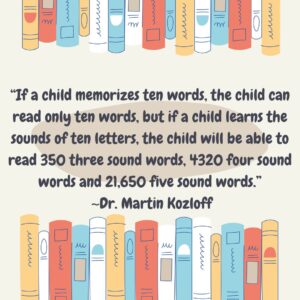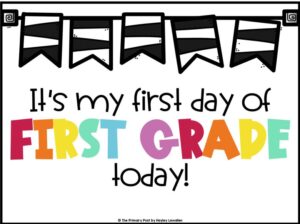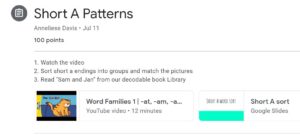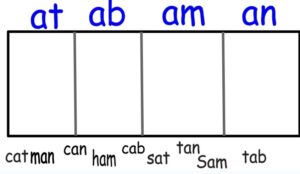Have you ever looked around during literacy stations and at your “listen to reading” station you see:
- Some students reading
- Some are only updating their avatar instead of reading
- Students disengaging with the reading material because they are not yet reading
Because SAME! As much as you pre-teach all of these skills and expectations when students are left to their own devices without supervision they do not always stay on task. It is also unfair to ask students to “listen to books” and “read to self” when they have not yet acquired those skills.
Grade 1 is a magical year, there is so much growth, and eventually, apps like Raz Kids are fantastic for students who are ready for it, but during the start of the year, our little learners are at very different stages in their reading development. I never loved using Raz Kids as my only listen-to reading station, but I felt it was easily accessible for the students and easy for me to implement as a teacher.
However, as I have gained experience in reading instruction, I have learned that there is a systematic way that you can teach fundamental reading skills that coincide with how students take in and process information.

Through my own development and research into the science of reading, I feel that I am not utilizing technology effectively during these literacy center times. I believe that if I can create a station with more explicit instruction that is differentiated for learning needs, I will have students engaging in more meaningful learning opportunities with a set goal in mind with the assistance of technology. The consequences of not addressing this need will result in students only staying on task for a small duration of the centers and not maximizing their learning potential when engaging in activities. It also creates more management work for the teacher who is tasked with teaching and monitoring their own small group.
Who are the learners?
In my class, the learners will be in grade 1, 6-7 years of age. This course will take place early in the year and continue until Christmas when students’ skills will then be reevaluated. These students are focusing on routines and procedures. They have been practicing using their Ipads leading up to this course but still require some assistance. The learners in this class vary in their reading ability. Most students are still working on letter recognition and letter sounds, while some are already starting to blend and read words.
Major Themes
The major overarching theme of this course is developing phonemic awareness and reading comprehension. Activities in this course will build on each other and grow with the students. Students will work on modules that are targeted toward their skill level at that time. There will be a variety of resources used that are engaging and appropriate for their age and skill level.
Learning environment

@HayleyLewallen
When working with small children there are always great opportunities but also limitations. Grade 1 students are typically eager to learn, they LOVE getting to use Ipads and try different things. The limitations are lack of independence, stamina, and attention span. However, with these limitations, there are opportunities to work on and build on these skills. As the teacher, I feel that it is a benefit to focus on small groups and adapt the lessons to the needs of my class. The modules also allow me to check for understanding or things I need to revisit. However, if there is no additional help in the room, I will be left with dealing with tech issues which will take away from focusing on my small group. Keeping activities up to date is also time-consuming and will take commitment. I think this content area is a great opportunity for students to get more targeted practice with specific skills that will help them become confident readers. I might find that some activities may end up being too hard/ easy for some. Using this technology will be relatively simple for students to access (with prior lessons learning how to do so) and is it laid out simply. It also can be used for when students are absent, and parents wish to have homework. My only fear is the student’s ability to log in and the teaching that will need to be done covering user error issues such as switching screens or tabs. By using this platform there will be no additional costs (other than perhaps buying online resources to use in the modules) but we have a class set of Ipads that are available to check out. I also have a set of 6 Ipads that stay in my room, as well as my teaching partner, therefore we can combine our Ipads when needed. The limitation of using this technology is our internet has been unreliable in the past, especially if multiple people are using it. Planning and coordinating will need to be done among myself and other teachers if I am using multiple sets of Ipads.
Course Level Objectives
The outcomes this course will be working towards are:
Listen to and comprehend a variety of texts (including a book read aloud, a person speaking, and directions) to retell the sequence and key points (who, what, when, where, why, and how).
Read and comprehend grade-appropriate texts (including narratives, informational texts, scripts, and poems) by relating the sequence (i.e., beginning, middle, and end), the key points (who, what, when, where, and why), and the problems and solutions.
My hope is that by the end of the course, my learners will be able to recognize and identify letters of the alphabet and their corresponding sounds, identify first, medial, and ending sounds, begin to blend and read CVC words, and sequence and identify main ideas of a story.
Instructional approach
What will this course look like? Learners will have access to videos focusing on a task or skill. There will be opportunities for hands-on activities after viewing these videos and lessons. Students will also participate in online activities such as online games or assignments. Students will also continue to use Raz Kids to test reading comprehension and sequencing of events. These learning experiences will last about 15-20 minutes and will be completed 1X/ week.
Assessments for this course will look like observations from myself or an educational assistant. Assignments such as word sorts and sequencing activities will be assessed. Raz kids’ data will also be used for assessing and understanding. At the end of the course, students will engage in 1 on 1 phonemic or reading (ORR) assessments with the teacher.
Platforms and Technology:
The platforms I plan to use are:
These platforms and technology will support student learning by:
- Creating opportunities for peer support and problem solving
- Differentiation among students
- Creating independence in learning outcomes
- Increase students’ comfort and confidence using technology
Course Design
I plan to have two classes to begin. The first course will progress from letter recognition, letter sounds, beginning sounds, medial vowel sounds, and ending sounds. It will also include Raz kid book readings as well as sequencing activities from YouTube read-aloud. Assessments for these skills will be a range of word and picture sorts, as well as Raz kid quizzes and sequence activities. The materials for these lessons will include, YouTube Videos, sorting, and sequencing activities on google slides, as well as online games.
The second course will progress from short vowel word families (ex at, am, ap, etc.), and progress through short e, I, o, and u word families, reading and changing CVC words, as well as, Raz Kids book readings and YouTube read-aloud sequencing activities. Assessment will also be a range of sorts, matching, online games, and Google slide assignments. The materials will include YouTube, Sorting, matching, and sequencing activities on google slides, as well as online games.


And there you have it! Click Here to see the ADDIE Template

Hi Anna! The modules you have planned sound great! I am always surprised by how quickly and adept students become at using technology. I taught a grade 1/2 split class for two periods in my timetable. We dove into using Toontasitc, and they were doing things with it that I didn’t even know about. The students became the teacher! Do you have access to Hearbuilder? It is software that can support student development of phonological awareness, auditory skills, sequencing, and listening skills. I have used it with some of the students I support as a Learning Support Teacher.
Looking forward to seeing the modules come together!
Hi Tammy, I have used hearbuilder in the past but we only purchase a few accounts for students who “qualify” for it. Unfortunately I find that with a lot of the apps our school has access too. Which makes it hard to utilize them in the way I would like to.
Hi Anna! Many of the issues with students being disengaged during reading stations is a common problem even in the higher elementary grades. As you noted, teaching routines is part of the solution but so is teaching kids within their zone of proximal development. To be engaged, students need to not only find the task interesting enough, it also needs to be a just-right task–not too hard, not too easy. I appreciate your responsiveness to your students by putting their learning needs first.
I look forward to seeing the rest of your course come together. Thanks for sharing!
Hi Anna,
I really enjoyed reading through your course profile. I typically teach Grades 4-5, so do not have much experience when it comes to students of a younger age. However, I did teach Grade 2 for a few months during the pandemic & I agree with you on the importance of teaching the skills needed for students to be successful while learning online. I was just filling in for a maternity leave, so there was lots I was planning to keep the same for that teacher, but there was also lots I was wanting to try to take on & experiment with. I was determined to make the learning for these kiddos exciting, yet beneficial. There is such importance in being a Grade 1-2 teacher & teaching them these skills! As someone who teachers higher end elementary it definitely does not go unnoticed when done properly. I look forward to seeing the walk through of your course & seeing all that you create.
-Kennedy
Anna, I am a high school teacher and cannot imagine the undertaking and challenge it is to incorporate technology into the classroom as grade 1 students probably require more assistance than my high school students do. That being said, I think that reading comprehension can always be incorporated more into the classroom as a good percentage of students struggle with these skills. I like the differentiation of your course as it will meet most if not all students’ needs.
I look forward to seeing how the whole course comes together!
Hi Anna,
Your considerate approach to meeting the various literacy development needs of your first-graders is very admirable. You are establishing a learning environment that caters to each student’s particular skills and encourages meaningful engagement when you recognize the value of clear instruction and differentiation. Your goal to use technology to aid in their education further exemplifies your dedication to utilizing cutting-edge resources for their advantage. Your efforts to create courses with specific goals, suitable delivery methods, and a range of assessments demonstrate your commitment to their development. Your pupils are fortunate to be learning to read with such a kind and committed teacher. All the best.
Hello, Anna! Excellent blog. I like how you differentiated the course since it will fulfil the demands of the majority, if not all, of your students.
I’m excited to see how the entire course comes together!